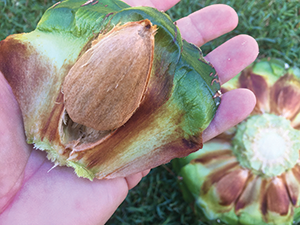


FEBRUARY is a great month of the year if you love bush tucker.
Why? Because bunya nuts are falling from bunya pine trees.
If you haven’t been bunya nutting or even tried eating these nuts, you are missing out on delightful bush tucker. Follow this simple recipe to learn how to cook them. My favourite method is boiling the nuts in salty water. An old favourite is to cook a piece of corned meat and use the flavours of the corned meat water to then boil the bunya nuts.
However, some prefer the nuts raw or roasted. Try them out to see which you prefer! Majestic bunya pine trees are easily identified from a distance by their tall dome profile and unusually deep green foliage. Their branches grow sideways and longer with age. They drop their pods containing the nuts in February.
Some years these trees will produce an exceptional crop when the season is just right, and mature trees will bear nuts each year, while young trees will not.
Their needle-like leaves are sharp and you will need good footwear if you are going to retrieve nuts from a tree. Use a pair of gloves when picking up the pods because they are spiky and sticky. Some pods break open when they hit the ground, otherwise you can open them with an axe.
Once inside the pod, you’ll see the nuts are capsulated in a wooden shell.
Twist the shell from the centre of the pod to extract the nut from each individual compartment. Each pod contains about 50 nuts. To open the nuts, you will need to use a knife and cut the nuts in half by following the centre line to remove the nut to eat. The bunya nut is a traditional food of the Australian Aboriginal people.
Nuts are traditionally eaten raw, roasted or pounded to make flour. Bunya pines are found in limited areas of rainforest, predominantly in southeastern Queensland, and especially in part of the Great Dividing Range now known as the Bunya Mountains National Park. Bunya pine trees grow almost anywhere along the Great Divide but fall times may differ depending upon climate.
Retrieve the nuts early in the season, otherwise you could miss out, as possums and sulphur-crested cockatoos also follow this food chain.
If you are having trouble dealing with the elements or cannot locate a tree don’t worry, as locals in the above areas sell the bunya pods at roadside stalls at this time of year.
Bunya nuts have exceptional eating quality similar to pine nuts in taste but much larger. They can be enjoyed many different ways and go much further than most nuts because of their size. Try them as mentioned above or boiled and later used in a salad or to create a beautiful pesto. l l l l l l l l l l l l l l l l l l l l l l l l l l l l l l l l
 Bush ‘n Beach Fishing Magazine Location reports & tips for fishing, boating, camping, kayaking, 4WDing in Queensland and Northern NSW
Bush ‘n Beach Fishing Magazine Location reports & tips for fishing, boating, camping, kayaking, 4WDing in Queensland and Northern NSW









